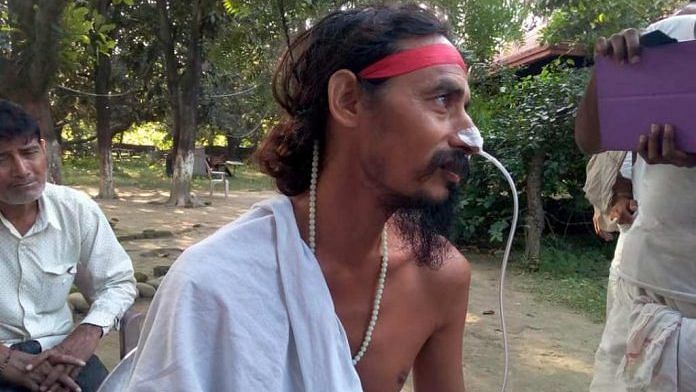The future of the dying river and its true crusaders hangs in balance.
Two months after noted environmentalist G.D. Agarwal died following his ‘fast unto death’ to make the Ganga ‘aviral’ (free-flowing), Gopal Das – a hermit from Haryana striking for the holy river – went missing.
Das, who had been fasting for more than 100 days at Haridwar’s Maitri Sadan (the hermitage where Agarwal had been fasting before his death), was last seen at Dehradun’s Doon Hospital. He had been rushed there for treatment on 5 December.
With the activist’s disappearance causing a furore, the Delhi High Court ordered the government to present Das before it.
After Agrawal’s death, a hard-pressed Uttarakhand government turned its focus on Das, moving the activist from one hospital to another – from Rishikesh to Dehradun.
Also read: Publicity hungry saints are fighting each other in the name of Ganga
Row in Rishikesh
It is alleged that Das was forcibly admitted to AIIMS Rishikesh and got into a scuffle with a junior resident at the hospital who blamed the activist for causing trouble.
Fearing for her son, Das’s mother appealed to the government to send him back home. She even launched a hunger strike at Rishikesh’s Dattatreya Ghat in protest. But there was no news of Das.
When his father sought answers from the AIIMS administration, they feigned ignorance about his whereabouts. Following political pressure, AIIMS director Randeep Guleria informed Das’s family that the activist had been relieved from the hospital upon his request.
How can a man who has been fasting for months be healthy and relieved from the hospital? Guleria alone would know.
Also read: Somnath Bharti says Modi responsible for disappearance of Ganga activist Sant Gopal Das
Lost in Doon
An AIIMS vehicle had taken Das to Dehradun from Rishikesh and dropped him outside the collector’s house. Stranded there and bleeding from his nose, Das reportedly called up a friend who brought him to the city’s Max Hospital. The private hospital denied him treatment since it was a legal case. Subsequently, he was moved to Doon Hospital and has been missing ever since.
The hospital administration, on the other hand, cited CCTV footage and claimed that Das left the premises of his own accord.
They should have made the footage public.
Before he went missing, Das had said he had no clue how he had reached Dehradun. He couldn’t fathom why Uttarakhand government was hell-bent on sending him ‘on medical tourism’.
Despite the high court order, the administration hasn’t made any progress. Citing Das’s friend Acharya Ravindra’s statement, the police claimed the activist was safe and that he was in Andhra Pradesh.
Curiously, soon after his statement was recorded at Hamirpur, Ravindra too went missing.
Did he speak under duress? And, if Das was in Andhra Pradesh, why didn’t the government try to find him?
Amid growing suspicion, the Uttarakhand government has told the court that Das is in the state. These differing statements are only adding to the mystery.
It begs asking, if the activist is in Uttarakhand, where is he – and why isn’t he in contact with anyone?
The Uttarakhand Police chief has refused to probe Das’s disappearance saying that he remains incommunicado as per his own choice. He perhaps doesn’t know what the high court order stands for.
To add to the murky state of affairs, Vikas, another friend of Das, too has gone missing.
The silence of the police in this case raises questions about its integrity.
It appears that Uttarakhand police believes by managing the media in this case of disappearances, it can dodge questions pertaining to why Ganga still remains dirty.
The dying river, and its crusaders
Such controversies are the reason the Ganga ministry is busy conducting seminars with international organisations even as Ganga activists are staging protests.
Also read: A Modi promise not kept: Images reveal how a pure Ganga turns disgustingly brown
It is possible that Das is under police supervision where he could be forced to eat.
Before he went missing, Das had spoken about psychological pressure as his friends were busy striking deals in his name.
G.D. Agrawal, too, was aggrieved that instead of fighting for the Ganga, activists were fighting to become leaders of Ganga activism.
The lives of the dying river and its true crusaders, meanwhile, hang in balance.
The author is a writer and journalist.
You can also read the story in Hindi here.






